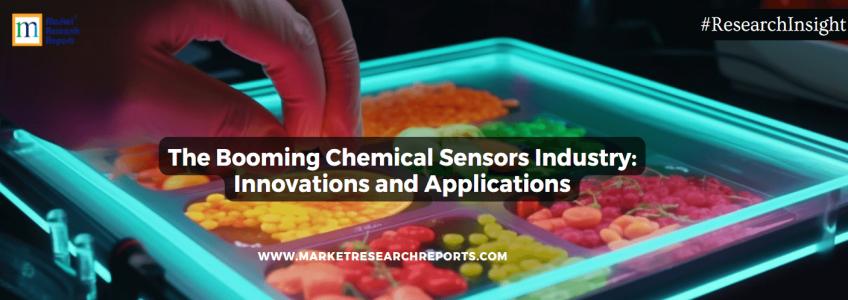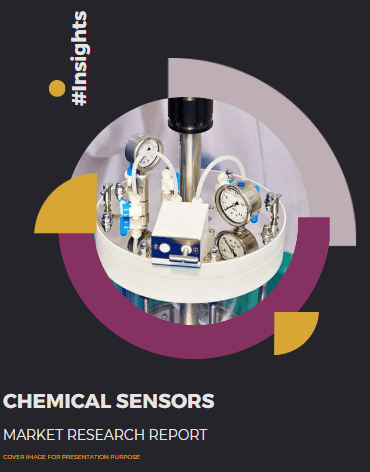The Booming Chemical Sensors Industry: Innovations and Applications

In today's world, chemical sensors play a pivotal role in various sectors, ranging from environmental monitoring and healthcare to industrial processes and defense applications. These devices are designed to detect and analyze the presence of specific chemicals or chemical properties, providing valuable data and insights for decision-making and safety purposes. The chemical sensors industry has experienced significant growth in recent years, driven by technological advancements, increasing environmental concerns, and the growing demand for real-time, accurate monitoring systems. This article explores the current state of the chemical sensors industry, its innovative technologies, and its wide-ranging applications.
1 . Overview of Chemical Sensors
Chemical sensors are analytical devices that convert chemical information into measurable signals. They work on selective interaction with target analytes, leading to a detectable physical or chemical change. These sensors can detect a wide range of substances, including gases, liquids, and solids, and they offer several advantages such as rapid response time, high sensitivity, and portability.
2 . Types of Chemical Sensors
The chemical sensors industry encompasses various sensor types designed for specific applications. Some commonly used types of chemical sensors include:
Gas Sensors: These sensors are designed to detect and measure the concentration of gases in the environment. They find extensive use in industrial safety, environmental monitoring, and indoor air quality control.
Example: Honeywell Sensepoint XRL Gas Detector
Honeywell offers a range of gas detection solutions, and one of their notable products is the Sensepoint XRL Gas Detector. This gas detector is designed to detect and monitor flammable gases and toxic gases in industrial environments. It utilizes advanced sensing technologies to provide accurate and reliable gas detection.
Electrochemical Sensors: These sensors measure the electrochemical properties of a target substance. They are widely used in biomedical applications, such as glucose monitoring for diabetes patients, as well as in environmental analysis and industrial processes.
Alphasense O2-A2 Oxygen Sensor
The Alphasense O2-A2 is an electrochemical oxygen sensor designed for accurate and reliable measurement of oxygen levels in ambient air or gases. It operates based on the principle of electrochemical reaction, where oxygen molecules react with the sensor's working electrode, generating a proportional electrical signal.
Optical Sensors: Optical sensors utilize light absorption, reflection, or emission to detect and quantify analytes. They offer high sensitivity and selectivity, making them suitable for applications such as chemical analysis, environmental monitoring, and food safety.
Biosensors: Biosensors incorporate biological components, such as enzymes or antibodies, to detect and quantify specific substances. They find applications in medical diagnostics, environmental monitoring, and food safety testing.
3 . Global Chemical Sensors Market Research Report:
4 . Technological Advancements
The chemical sensors industry has witnessed remarkable technological advancements, leading to the development of more efficient and accurate sensor systems. Some notable innovations include:
Nanotechnology: Nanomaterials, such as carbon nanotubes, graphene, and nanoparticles, have revolutionized chemical sensing. Their large surface area and unique properties enable enhanced sensitivity and selectivity, paving the way for improved gas sensors, biosensors, and environmental monitoring devices.
Internet of Things (IoT) Integration: The integration of chemical sensors with IoT platforms has enabled real-time data collection and remote monitoring. IoT-enabled chemical sensors find applications in smart cities, industrial automation, and environmental monitoring networks.
Miniaturization and Wearable Sensors: The miniaturization of chemical sensors has enabled their integration into wearable devices, allowing continuous monitoring of vital signs, environmental pollutants, and personal exposure levels. These advancements have opened new avenues for personalized healthcare, fitness tracking, and occupational safety.
Machine Learning and Artificial Intelligence: By combining chemical sensing with machine learning algorithms, sensors can improve accuracy, recognize patterns, and provide predictive analytics. This integration has enhanced the capabilities of chemical sensors in various fields, including environmental monitoring, quality control, and security.
5 . Applications of Chemical Sensors
The widespread adoption of chemical sensors across industries has led to diverse applications. Some notable areas where chemical sensors are employed include:
Environmental Monitoring: Chemical sensors play a crucial role in monitoring air and water quality, detecting pollutants, and ensuring compliance with environmental regulations. They are used in urban air quality monitoring networks, industrial emissions control, and water treatment facilities.
Healthcare and Medical Diagnostics: Chemical sensors are extensively used in medical diagnostics, including blood glucose monitoring, detection of biomarkers for diseases, and breath analysis for diagnosing conditions such as respiratory disorders and infectious diseases. They enable non-invasive and rapid testing, improving patient care and facilitating early disease detection.
Industrial Processes: Chemical sensors are vital in industrial settings, where they help monitor and control various processes. They are used for detecting leaks, measuring gas concentrations, and ensuring worker safety in industries such as oil and gas, chemical manufacturing, and mining.
Food Safety and Quality Control: Chemical sensors are employed to detect contaminants, such as pesticides, heavy metals, and microbial pathogens, in food and beverages. They ensure food safety and quality by providing real-time analysis and enabling quick identification of potential hazards.
Defense and Security: Chemical sensors are essential in defense and security applications, including the detection of chemical warfare agents, explosives, and illicit drugs. They are used in airports, border control, and military operations to ensure public safety and national security.
Smart Agriculture: Chemical sensors aid in precision agriculture by monitoring soil conditions, nutrient levels, and pesticide concentrations. They help optimize farming practices, reduce resource usage, and enhance crop productivity.
Air Quality Control in Buildings: Chemical sensors monitor indoor air quality in buildings, including homes, offices, and public spaces. They detect pollutants, such as volatile organic compounds (VOCs), and ensure a healthy and comfortable environment for occupants.
Example: Chemical sensors used in food safety and quality control is a Biosensor for detecting foodborne pathogens
Biosensors are analytical devices that combine a biological component (such as enzymes or antibodies) with a physicochemical transducer to detect and quantify specific substances. In food safety and quality control, biosensors can detect pathogens, such as bacteria or viruses, that can cause foodborne illnesses.
These biosensors typically consist of a biological recognition element, such as antibodies or aptamers, that specifically bind to the target pathogen and a transducer that converts the binding event into a measurable signal. Depending on the specific biosensor design, the transducer can be optical, electrochemical, or piezoelectric.
For instance, an optical biosensor for food safety may use a fluorescent or colorimetric label that produces a signal when the target pathogen is present. The label is attached to the biological recognition element, and when it binds to the pathogen, it undergoes a detectable change in fluorescence or color.
Similarly, an electrochemical biosensor may use electrodes coated with the biological recognition element. When the pathogen binds to the recognition element, it causes a change in the electrical properties of the electrodes, generating a measurable current or voltage signal.
These biosensors offer several advantages for food safety and quality control. They are highly sensitive, allowing for the detection of low pathogen concentrations, and provide rapid results, often within minutes. Biosensors can be used in different food production and distribution stages, from testing raw materials and ingredients to monitoring the final product. They enable on-site testing, reducing the reliance on centralized laboratories and providing quick feedback for immediate action.
The application of biosensors for food safety and quality control can enhance public health by rapidly detecting foodborne pathogens, preventing outbreaks, and ensuring the safety of food products. Their use can help identify contaminated batches, trigger recall procedures, and facilitate proactive measures to maintain food quality standards.
It is important to note that biosensors are just one type of chemical sensor used in food safety and quality control. Other chemical sensors, such as gas or spectroscopic sensors, may also be employed for detecting chemical contaminants or monitoring food storage conditions. The appropriate sensor selection depends on the specific analytes of interest and the desired detection limits.
6 . Market Trends and Outlook
The chemical sensors industry is experiencing rapid growth, driven by increasing demand for real-time monitoring and the need for improved safety and environmental regulations. Several market trends are shaping the industry's future:
Demand for Portable and Wireless Sensors: There is a growing demand for portable and wireless chemical sensors that can be easily deployed in various environments. These sensors enable on-site monitoring, data collection, and analysis, providing instant results and reducing dependence on laboratory testing.
Emphasis on Selectivity and Sensitivity: With the increasing complexity of chemical environments, there is a growing need for sensors that offer high selectivity and sensitivity. Researchers and manufacturers are focusing on developing sensors that can accurately distinguish between similar compounds and detect trace levels of analytes.
Collaborations and Partnerships: The chemical sensors industry is witnessing collaborations between sensor manufacturers, technology companies, and research institutions. These partnerships aim to leverage expertise, share resources, and accelerate the development of innovative sensor technologies.






